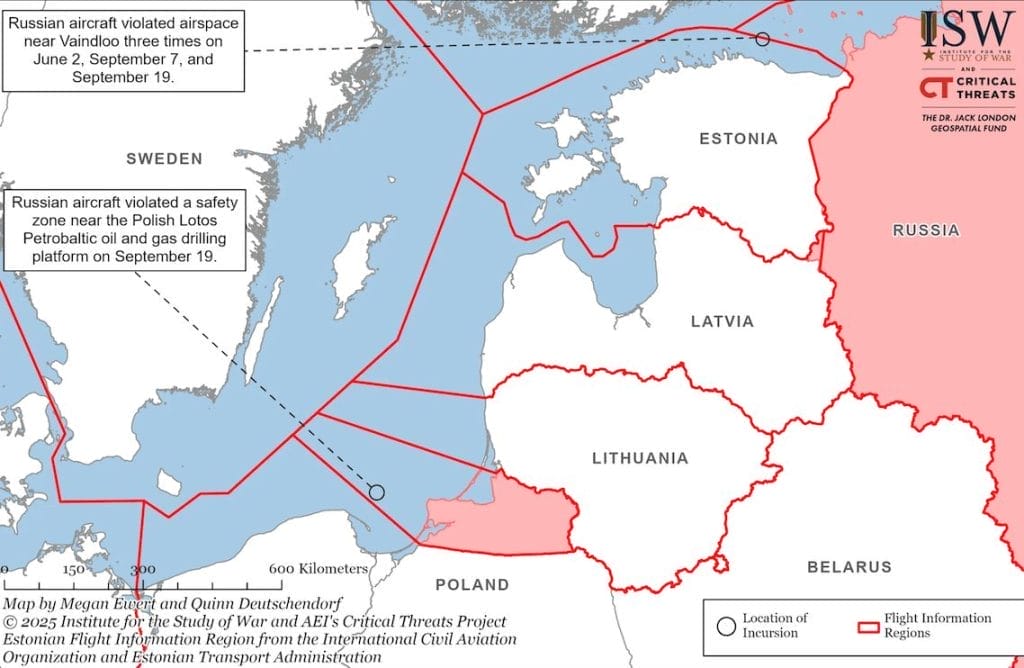
In the last few days, Russia has escalated its provocations against European countries, testing their reactions. First, on September 11th, a series of Russian drones violated Polish airspace. The drones, reportedly military-grade, crossed into Poland and damaged a few buildings during a period of increased vigilance along NATO’s eastern flank. Polish authorities swiftly responded, scrambling defence systems and lodging a formal protest with Moscow. A few days later, Russian drones penetrated Romanian airspace, alarming authorities and intensifying regional security concerns. The brief incursion was swiftly detected by Romanian defence systems, prompting a heightened alertness and diplomatic action. On Friday 19th, three Russian MiG-31 fighter jets entered the Estonian skies“without permission and remained there for a total of 12 minutes”, over the Gulf of Finland, the government said.
These incursions are widely interpreted as a deliberate provocation carried out by Russia, aimed at testing the responses and resolve of European nations. They have reignited concerns over border security and the stability of Eastern Europe, given the growing unpredictability of Russian military tactics. They have also sparked renewed discussions among NATO members about collective defence and the need for enhanced surveillance capabilities amid rising tensions in the region, as both Poland and Estonia have invoked Article 4 of NATO, which precedes the activation of Article 5.
Why is Russia acting like this? In a recent article published by Bloomberg, Kremlin sources say that Putin may step up Russian attackson Ukraine and Europe, knowing that Trump will not react, a conviction that has grown since the meeting in Alaska. The US Presidentdid recently say that he was “disappointed” by Putin, but did not do much to force him to the negotiating table. Trump pushed the Europeans to stop buying any forms of energy from Russia, to avoid indirectly financing Russia’s military efforts. And this is what Europe did: with its 11th package of sanctions against Russia, the EU has severed all its residual ties with Russia. “It’s time to close the tap” said the EU Commission President Ursula von der Leyen, presenting these sanctions.
It’s unclear whether this is going to be enough, though. Putin knows that Trump will not intervene to defend European countries, and so Russia can further escalate its military provocations to test the European response, which is likely to be inadequate at best.
To exemplify how feeble the European reaction could be, General Richard Shirreff, a former Deputy Supreme Allied Commander Europe, described in a recent article for the Daily Mail “How the West will come to a bloody end in World War 3.” The article paints a stark and alarming picture of a potential global conflict triggered by escalating tensions with Russia.
Drawing on his military expertise, Shirreff outlines how a series of miscalculations and provocative actions — such as the incursions into NATO airspace and hybrid warfare tactics discussed above — could rapidly spiral out of control. He warns that NATO’s eastern flank remains dangerously exposed, and that the alliance’s deterrence measures may be insufficient to prevent Russian aggression. With Western political resolve perceived as weak and divided, particularly in light of ambiguous signals from the United States, Shirreff argues that Russia may be emboldened to take further steps, potentially leading to open conflict in Eastern Europe. If such a war were to occur, Europe may be overwhelmed within just five days, and the world order that we know would be overhauled.